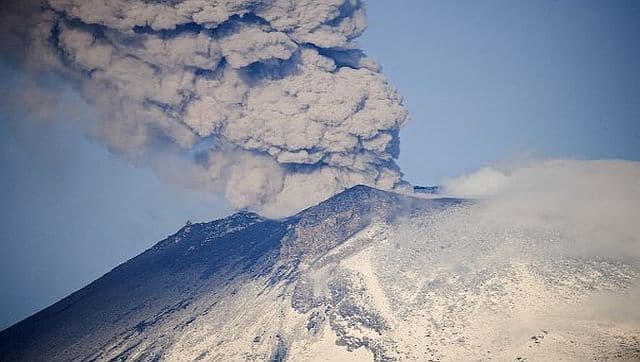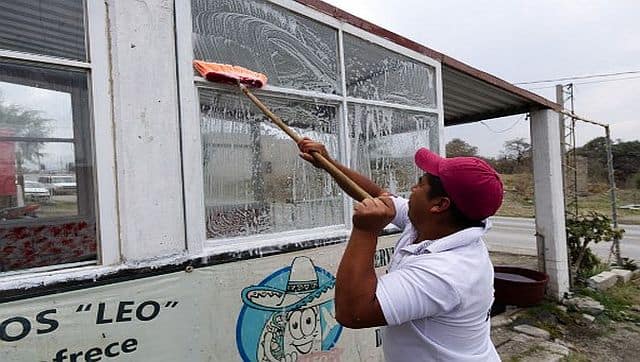A volcano near Mexico City is spewing intense ash, smoke and gas. Towering a couple of hours from one of the world’s largest cities, the Popocatepetl volcano has been coating nearby towns with ash and disrupting flights at Mexico City’s airport, the busiest in Latin America. Hundreds of explosions have spit lava from the snow-tipped peak of the 17,797-foot Popocatepetl (puh-puh-ka-TEH-pet-tl). Dozens of flights out of Mexico City were cancelled over the weekend due to worsened activity. After heightened activity from the country’s most deadly active volcano, millions of Mexicans have been told to prepare for an evacuation. On Sunday, authorities increased their warning level to one step below red alert, which, if reached, would mean evacuation for thousands living near the volcano, whose name means “smoking mountain” in the indigenous Nahuatl language. Approximately 25 million people live within 60 miles of the mountain. Volcanologists say that, while a massive eruption doesn’t appear imminent, eruptions are likely to continue, as they have for three decades. Here’s a closer look at what’s going on. What is happening with the Popocatepetl volcano? The Popocatepetl volcano near Mexico City has been erupting on and off since 1994, but it has rumbled every day for the past week. Hundreds of explosions have been recorded by scientists, and webcams trained on the volcano have revealed it to be spewing incandescent debris. A column of ash can be seen rising from the top. Popocatépetl is an active stratovolcano located 70 km (43 miles) southeast of Mexico City that has had three major eruptions since the mid-Holocene. [caption id=“attachment_12647222” align=“alignnone” width=“640”] Ash and smoke billow from the Popocatepetl volcano as seen from the Santiago Xalitzintla community, state of Puebla, Mexico. AFP[/caption] How dangerous has ‘Popo’ been? The volcano known as “Popo”, had periods of intense activity between 2000 and 2003, and again between 2012 and 2016. In 2000, that activity triggered a red alert and evacuations before the volcano calmed down again. In the past weeks, the volcano entered another one of those periods, spewing ash, gas and lava. Authorities have increased the alert to yellow, the second level on a stoplight-style scale, but not yet to red. Popocatepetl saw similar episodes in the late 1990s and early 2000s, although the current phase could potentially “go in a more dangerous direction,” said the National Autonomous University of Mexico researcher, reports NDTV. In 1997, intense activity blanketed parts of Mexico City in thick layers of ash, which can cause respiratory illness and clogged drains.
Also Read: The Hill That Smokes: Mexico City airport halts after volcanic ash disruption
Previous surges in activity date back centuries. Pre-Hispanic writings speak of intense activity at Popocatepetl at the beginning of the 16th Century. In Guatemala, the Volcano of Fire claimed the lives of hundreds of people in a 2018 eruption. It has recently prompted evacuations for heightened activity as well. Is a major eruption imminent? Scientists and Mexican authorities say there’s no sign that the current waves of small eruptions at Popocatepetl will turn into anything more destructive, said Servando de la Cruz Reyna, a senior geophysics researcher at the UNAM in Mexico City, adding that is there “nothing new or surprising” about recent movements. “The probability that this continues as it has previously is far higher than the probability that this grows to much higher levels,” he said. Popocatepetl has been active for a half-million years. Its last major eruption happened more than a thousand years ago. There are over 2,000 volcanoes in Mexico, of which 48 are active or potentially active. Almost two-thirds of the country’s population lives on the ground shaped by volcanic activity What is the government doing? Experts are continually monitoring seismic activity surrounding the volcano, as well as the composition of the materials and gases it spews out, in order to forecast a possible large eruption. [caption id=“attachment_12647232” align=“alignnone” width=“640”]
Ash and smoke billow from the Popocatepetl volcano as seen from the Santiago Xalitzintla community, state of Puebla, Mexico. AFP[/caption] How dangerous has ‘Popo’ been? The volcano known as “Popo”, had periods of intense activity between 2000 and 2003, and again between 2012 and 2016. In 2000, that activity triggered a red alert and evacuations before the volcano calmed down again. In the past weeks, the volcano entered another one of those periods, spewing ash, gas and lava. Authorities have increased the alert to yellow, the second level on a stoplight-style scale, but not yet to red. Popocatepetl saw similar episodes in the late 1990s and early 2000s, although the current phase could potentially “go in a more dangerous direction,” said the National Autonomous University of Mexico researcher, reports NDTV. In 1997, intense activity blanketed parts of Mexico City in thick layers of ash, which can cause respiratory illness and clogged drains.
Also Read: The Hill That Smokes: Mexico City airport halts after volcanic ash disruption
Previous surges in activity date back centuries. Pre-Hispanic writings speak of intense activity at Popocatepetl at the beginning of the 16th Century. In Guatemala, the Volcano of Fire claimed the lives of hundreds of people in a 2018 eruption. It has recently prompted evacuations for heightened activity as well. Is a major eruption imminent? Scientists and Mexican authorities say there’s no sign that the current waves of small eruptions at Popocatepetl will turn into anything more destructive, said Servando de la Cruz Reyna, a senior geophysics researcher at the UNAM in Mexico City, adding that is there “nothing new or surprising” about recent movements. “The probability that this continues as it has previously is far higher than the probability that this grows to much higher levels,” he said. Popocatepetl has been active for a half-million years. Its last major eruption happened more than a thousand years ago. There are over 2,000 volcanoes in Mexico, of which 48 are active or potentially active. Almost two-thirds of the country’s population lives on the ground shaped by volcanic activity What is the government doing? Experts are continually monitoring seismic activity surrounding the volcano, as well as the composition of the materials and gases it spews out, in order to forecast a possible large eruption. [caption id=“attachment_12647232” align=“alignnone” width=“640”] A man cleans the ash spewed by the Popocatépetl volcano from the windows of a restaurant in San Nicolas de los Ranchos, Puebla State, Mexico. AFP[/caption] Authorities have closed schools in dozens of municipalities across three states, put troops on alert, prepared shelters and checked evacuation routes. Other than that, they are encouraging people to remain calm. On Monday, Mexican president Andrés Manuel López Obrador said in his morning briefing that “the movements of the volcano are being monitored 24 hours a day.” Authorities have warned people not to go within 12 kilometres (7.5 miles) of Popocatepetl, and to use face masks due to the falling ash. Troops have also been deployed to sweep up ash in the streets. What is likely to happen? Popocatepetl’s recent activity is not necessarily a bad thing, said Robin Campion, a volcanologist at the Institute of Geophysics. The scientist explained that small explosions alleviate pressure from magma inside the mountain, and likely mean that it won’t lead to a build-up and larger eruption. “The good thing is that … it’s constantly releasing energy,” Campion said. “Hopefully, it’ll continue being as constant and moderate as it is, so it doesn’t all erupt at once, like it did in prehistoric times.” As it continues puffing, ash could eventually become a problem in surrounding areas, particularly in the 7.5 miles surrounding the volcano, but also in Mexico City. While the ash is not toxic, Carlos Valdés, head of UNAM’s National Seismological Service, said it could affect breathing and air quality and also continue to affect flights to and from Mexico City’s international airport. While the ash continues to billow toward southern Mexico, he and other scientists monitoring the volcano expect winds to shift and blow ash into the capital in June. Already on Saturday, volcanic ash carried in by shifting winds forced the city’s airport to temporarily shut down. Others expressed worries that the weight of ash building up could collapse precariously constructed homes in poorer areas of Mexico. They have recommended residents wash their eyes and wear face masks. “It has had important consequences. The only danger we’re really entertaining right now is the ash,” Valdés said. “People shouldn’t be scared, more than anything they should take precautions.” With inputs from agencies Read all the Latest News
, Trending News
, Cricket News
, Bollywood News
, India News
and Entertainment News
here. Follow us on
Facebook
,
Twitter
and
Instagram
.
A man cleans the ash spewed by the Popocatépetl volcano from the windows of a restaurant in San Nicolas de los Ranchos, Puebla State, Mexico. AFP[/caption] Authorities have closed schools in dozens of municipalities across three states, put troops on alert, prepared shelters and checked evacuation routes. Other than that, they are encouraging people to remain calm. On Monday, Mexican president Andrés Manuel López Obrador said in his morning briefing that “the movements of the volcano are being monitored 24 hours a day.” Authorities have warned people not to go within 12 kilometres (7.5 miles) of Popocatepetl, and to use face masks due to the falling ash. Troops have also been deployed to sweep up ash in the streets. What is likely to happen? Popocatepetl’s recent activity is not necessarily a bad thing, said Robin Campion, a volcanologist at the Institute of Geophysics. The scientist explained that small explosions alleviate pressure from magma inside the mountain, and likely mean that it won’t lead to a build-up and larger eruption. “The good thing is that … it’s constantly releasing energy,” Campion said. “Hopefully, it’ll continue being as constant and moderate as it is, so it doesn’t all erupt at once, like it did in prehistoric times.” As it continues puffing, ash could eventually become a problem in surrounding areas, particularly in the 7.5 miles surrounding the volcano, but also in Mexico City. While the ash is not toxic, Carlos Valdés, head of UNAM’s National Seismological Service, said it could affect breathing and air quality and also continue to affect flights to and from Mexico City’s international airport. While the ash continues to billow toward southern Mexico, he and other scientists monitoring the volcano expect winds to shift and blow ash into the capital in June. Already on Saturday, volcanic ash carried in by shifting winds forced the city’s airport to temporarily shut down. Others expressed worries that the weight of ash building up could collapse precariously constructed homes in poorer areas of Mexico. They have recommended residents wash their eyes and wear face masks. “It has had important consequences. The only danger we’re really entertaining right now is the ash,” Valdés said. “People shouldn’t be scared, more than anything they should take precautions.” With inputs from agencies Read all the Latest News
, Trending News
, Cricket News
, Bollywood News
, India News
and Entertainment News
here. Follow us on
Facebook
,
Twitter
and
Instagram
.
Roofs tremble and nerves fray: How a volcano has Mexico City on edge
FP Explainers
• May 25, 2023, 18:42:47 IST
The Popocatepetl volcano near Mexico City is spewing intense ash, smoke and gas. Flights have been cancelled and schools shut. Its last major eruption happened more than a thousand years ago. Is a big disaster coming?
Advertisement
)
End of Article